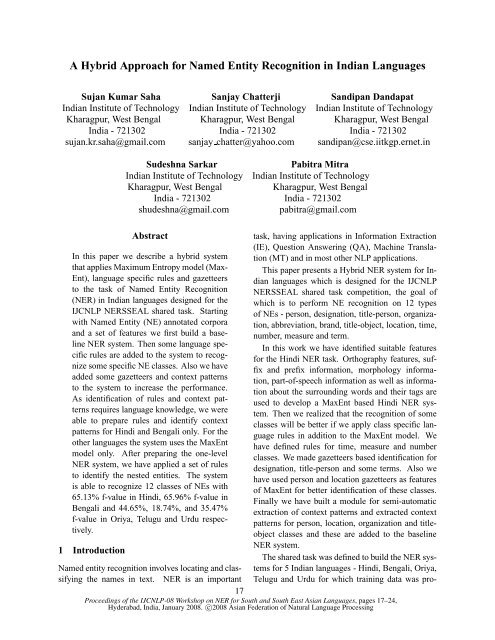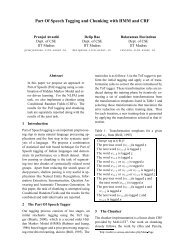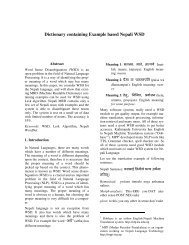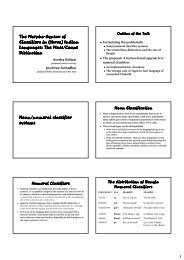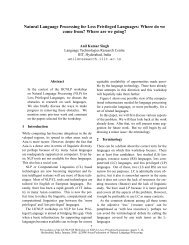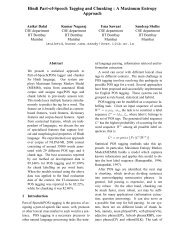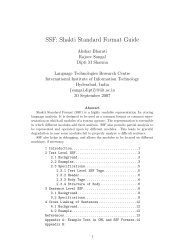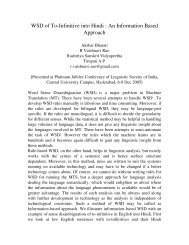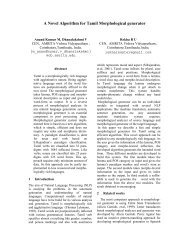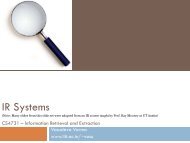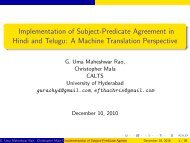A Hybrid Approach for Named Entity Recognition in Indian Languages
A Hybrid Approach for Named Entity Recognition in Indian Languages
A Hybrid Approach for Named Entity Recognition in Indian Languages
Create successful ePaper yourself
Turn your PDF publications into a flip-book with our unique Google optimized e-Paper software.
A <strong>Hybrid</strong> <strong>Approach</strong> <strong>for</strong> <strong>Named</strong> <strong>Entity</strong> <strong>Recognition</strong> <strong>in</strong> <strong>Indian</strong> <strong>Languages</strong><br />
Sujan Kumar Saha Sanjay Chatterji Sandipan Dandapat<br />
<strong>Indian</strong> Institute of Technology <strong>Indian</strong> Institute of Technology <strong>Indian</strong> Institute of Technology<br />
Kharagpur, West Bengal Kharagpur, West Bengal Kharagpur, West Bengal<br />
India - 721302 India - 721302 India - 721302<br />
sujan.kr.saha@gmail.com sanjay chatter@yahoo.com sandipan@cse.iitkgp.ernet.<strong>in</strong><br />
Sudeshna Sarkar<br />
Pabitra Mitra<br />
<strong>Indian</strong> Institute of Technology <strong>Indian</strong> Institute of Technology<br />
Kharagpur, West Bengal<br />
Kharagpur, West Bengal<br />
India - 721302 India - 721302<br />
shudeshna@gmail.com<br />
pabitra@gmail.com<br />
Abstract<br />
In this paper we describe a hybrid system<br />
that applies Maximum Entropy model (Max-<br />
Ent), language specific rules and gazetteers<br />
to the task of <strong>Named</strong> <strong>Entity</strong> <strong>Recognition</strong><br />
(NER) <strong>in</strong> <strong>Indian</strong> languages designed <strong>for</strong> the<br />
IJCNLP NERSSEAL shared task. Start<strong>in</strong>g<br />
with <strong>Named</strong> <strong>Entity</strong> (NE) annotated corpora<br />
and a set of features we first build a basel<strong>in</strong>e<br />
NER system. Then some language specific<br />
rules are added to the system to recognize<br />
some specific NE classes. Also we have<br />
added some gazetteers and context patterns<br />
to the system to <strong>in</strong>crease the per<strong>for</strong>mance.<br />
As identification of rules and context patterns<br />
requires language knowledge, we were<br />
able to prepare rules and identify context<br />
patterns <strong>for</strong> H<strong>in</strong>di and Bengali only. For the<br />
other languages the system uses the MaxEnt<br />
model only. After prepar<strong>in</strong>g the one-level<br />
NER system, we have applied a set of rules<br />
to identify the nested entities. The system<br />
is able to recognize 12 classes of NEs with<br />
65.13% f-value <strong>in</strong> H<strong>in</strong>di, 65.96% f-value <strong>in</strong><br />
Bengali and 44.65%, 18.74%, and 35.47%<br />
f-value <strong>in</strong> Oriya, Telugu and Urdu respectively.<br />
1 Introduction<br />
<strong>Named</strong> entity recognition <strong>in</strong>volves locat<strong>in</strong>g and classify<strong>in</strong>g<br />
the names <strong>in</strong> text. NER is an important<br />
task, hav<strong>in</strong>g applications <strong>in</strong> In<strong>for</strong>mation Extraction<br />
(IE), Question Answer<strong>in</strong>g (QA), Mach<strong>in</strong>e Translation<br />
(MT) and <strong>in</strong> most other NLP applications.<br />
This paper presents a <strong>Hybrid</strong> NER system <strong>for</strong> <strong>Indian</strong><br />
languages which is designed <strong>for</strong> the IJCNLP<br />
NERSSEAL shared task competition, the goal of<br />
which is to per<strong>for</strong>m NE recognition on 12 types<br />
of NEs - person, designation, title-person, organization,<br />
abbreviation, brand, title-object, location, time,<br />
number, measure and term.<br />
In this work we have identified suitable features<br />
<strong>for</strong> the H<strong>in</strong>di NER task. Orthography features, suffix<br />
and prefix <strong>in</strong><strong>for</strong>mation, morphology <strong>in</strong><strong>for</strong>mation,<br />
part-of-speech <strong>in</strong><strong>for</strong>mation as well as <strong>in</strong><strong>for</strong>mation<br />
about the surround<strong>in</strong>g words and their tags are<br />
used to develop a MaxEnt based H<strong>in</strong>di NER system.<br />
Then we realized that the recognition of some<br />
classes will be better if we apply class specific language<br />
rules <strong>in</strong> addition to the MaxEnt model. We<br />
have def<strong>in</strong>ed rules <strong>for</strong> time, measure and number<br />
classes. We made gazetteers based identification <strong>for</strong><br />
designation, title-person and some terms. Also we<br />
have used person and location gazetteers as features<br />
of MaxEnt <strong>for</strong> better identification of these classes.<br />
F<strong>in</strong>ally we have built a module <strong>for</strong> semi-automatic<br />
extraction of context patterns and extracted context<br />
patterns <strong>for</strong> person, location, organization and titleobject<br />
classes and these are added to the basel<strong>in</strong>e<br />
NER system.<br />
The shared task was def<strong>in</strong>ed to build the NER systems<br />
<strong>for</strong> 5 <strong>Indian</strong> languages - H<strong>in</strong>di, Bengali, Oriya,<br />
Telugu and Urdu <strong>for</strong> which tra<strong>in</strong><strong>in</strong>g data was pro-<br />
17<br />
Proceed<strong>in</strong>gs of the IJCNLP-08 Workshop on NER <strong>for</strong> South and South East Asian <strong>Languages</strong>, pages 17–24,<br />
Hyderabad, India, January 2008. c○2008 Asian Federation of Natural Language Process<strong>in</strong>g
vided. Among these 5 languages only Bengali and<br />
H<strong>in</strong>di are known to us but we have no knowledge <strong>for</strong><br />
other 3 languages. So we are unable to build rules<br />
and extract context patterns <strong>for</strong> these languages. The<br />
NER systems <strong>for</strong> these 3 languages conta<strong>in</strong> only<br />
the basel<strong>in</strong>e system i.e. the MaxEnt system. Also<br />
our basel<strong>in</strong>e MaxEnt NER system uses morphological<br />
and parts-of-speech (POS) <strong>in</strong><strong>for</strong>mation as a feature.<br />
Due to unavailability of morphological analyzer<br />
and POS tagger <strong>for</strong> these 3 languages, these <strong>in</strong><strong>for</strong>mation<br />
are not added to the systems. Among the<br />
3 languages, only <strong>for</strong> Oriya NER system we have<br />
used small gazetteers <strong>for</strong> person, location and designation<br />
extracted from the tra<strong>in</strong><strong>in</strong>g data. For Bengali<br />
and H<strong>in</strong>di the developed systems are complete<br />
hybrid systems conta<strong>in</strong><strong>in</strong>g rules, gazetteers, context<br />
patterns and the MaxEnt model.<br />
The paper is organized as follows. A brief survey<br />
of different techniques used <strong>for</strong> the NER task<br />
<strong>in</strong> different languages and doma<strong>in</strong>s are presented <strong>in</strong><br />
Section 2. Also a brief survey on nested NE recognition<br />
system is presented here. A discussion on<br />
the tra<strong>in</strong><strong>in</strong>g data is given <strong>in</strong> Section 3. The MaxEnt<br />
based NER system is described <strong>in</strong> Section 4. Various<br />
features used <strong>in</strong> NER are then discussed. Next<br />
we present the experimental results and related discussions<br />
<strong>in</strong> Section 8. F<strong>in</strong>ally Section 9 concludes<br />
the paper.<br />
2 Previous Work<br />
A variety of techniques has been used <strong>for</strong> NER. The<br />
two major approaches to NER are:<br />
1. L<strong>in</strong>guistic approaches.<br />
2. Mach<strong>in</strong>e Learn<strong>in</strong>g (ML) based approaches.<br />
The l<strong>in</strong>guistic approaches typically use rules manually<br />
written by l<strong>in</strong>guists. There are several rulebased<br />
NER systems, conta<strong>in</strong><strong>in</strong>g ma<strong>in</strong>ly lexicalized<br />
grammar, gazetteer lists, and list of trigger words,<br />
which are capable of provid<strong>in</strong>g 88%-92% f-measure<br />
accuracy <strong>for</strong> English (Grishman, 1995; McDonald,<br />
1996; Wakao et al., 1996).<br />
The ma<strong>in</strong> disadvantages of these rule-based techniques<br />
are that these require huge experience and<br />
grammatical knowledge of the particular language<br />
or doma<strong>in</strong> and these systems are not transferable to<br />
other languages or doma<strong>in</strong>s.<br />
18<br />
ML based techniques <strong>for</strong> NER make use of a<br />
large amount of NE annotated tra<strong>in</strong><strong>in</strong>g data to acquire<br />
high level language knowledge. Several ML<br />
techniques have been successfully used <strong>for</strong> the NER<br />
task of which Hidden Markov Model (HMM) (Bikel<br />
et al., 1997), Maximum Entropy (MaxEnt) (Borthwick,<br />
1999), Conditional Random Field (CRF) (Li<br />
and Mccallum, 2004) are most common. Comb<strong>in</strong>ations<br />
of different ML approaches are also used. Srihari<br />
et al. (2000) comb<strong>in</strong>es MaxEnt, Hidden Markov<br />
Model (HMM) and handcrafted rules to build an<br />
NER system.<br />
NER systems use gazetteer lists <strong>for</strong> identify<strong>in</strong>g<br />
names. Both the l<strong>in</strong>guistic approach (Grishman,<br />
1995; Wakao et al., 1996) and the ML based approach<br />
(Borthwick, 1999; Srihari et al., 2000) use<br />
gazetteer lists.<br />
L<strong>in</strong>guistic approach uses handcrafted rules which<br />
needs skilled l<strong>in</strong>guistics. Some recent approaches<br />
try to learn context patterns through ML which reduce<br />
amount of manual labour. Talukder et al.(2006)<br />
comb<strong>in</strong>ed grammatical and statistical techniques to<br />
create high precision patterns specific <strong>for</strong> NE extraction.<br />
An approach to lexical pattern learn<strong>in</strong>g <strong>for</strong> <strong>Indian</strong><br />
languages is described by Ekbal and Bandopadhyay<br />
(2007). They used seed data and annotated corpus<br />
to f<strong>in</strong>d the patterns <strong>for</strong> NER.<br />
The NER task <strong>for</strong> H<strong>in</strong>di has been explored by<br />
Cucerzan and Yarowsky <strong>in</strong> their language <strong>in</strong>dependent<br />
NER work which used morphological and contextual<br />
evidences (Cucerzan and Yarowsky, 1999).<br />
They ran their experiment with 5 languages - Romanian,<br />
English, Greek, Turkish and H<strong>in</strong>di. Among<br />
these the accuracy <strong>for</strong> H<strong>in</strong>di was the worst. For<br />
H<strong>in</strong>di the system achieved 41.70% f-value with a<br />
very low recall of 27.84% and about 85% precision.<br />
A more successful H<strong>in</strong>di NER system was developed<br />
by Wei Li and Andrew Mccallum (2004) us<strong>in</strong>g<br />
Conditional Random Fields (CRFs) with feature <strong>in</strong>duction.<br />
They were able to achieve 71.50% f-value<br />
us<strong>in</strong>g a tra<strong>in</strong><strong>in</strong>g set of size 340k words. In H<strong>in</strong>di<br />
the maximum accuracy is achieved by Kumar and<br />
Bhattacharyya, (2006). Their Maximum Entropy<br />
Markov Model (MEMM) based model gives 79.7%<br />
f-value.<br />
All the NER systems described above are able<br />
to detect one-level NEs. In recent years, the <strong>in</strong>terest<br />
<strong>in</strong> detection of nested NEs has <strong>in</strong>creased. Here
we mention few attempts <strong>for</strong> nested NE detection.<br />
Zhou et al. (2004) described an approach to identify<br />
cascaded NEs from biomedical texts. They detected<br />
the <strong>in</strong>nermost NEs first and then they derived<br />
rules to f<strong>in</strong>d the other NEs conta<strong>in</strong><strong>in</strong>g these as substr<strong>in</strong>gs.<br />
Another approach, described by McDonald<br />
et al. (2005), uses structural multilevel classification<br />
to deal with overlapp<strong>in</strong>g and discont<strong>in</strong>uous entities.<br />
B. Gu (2006) has treated the task of identify<strong>in</strong>g<br />
the nested NEs a b<strong>in</strong>ary classification problem and<br />
solved it us<strong>in</strong>g support vector mach<strong>in</strong>es. For each<br />
token <strong>in</strong> nested NEs, they used two schemes to set<br />
its class label: label<strong>in</strong>g as the outermost entity or the<br />
<strong>in</strong>ner entities.<br />
3 Tra<strong>in</strong><strong>in</strong>g Data<br />
The data used <strong>for</strong> the tra<strong>in</strong><strong>in</strong>g of the systems was<br />
provided. The annotated data uses Shakti Standard<br />
Format (SSF). For our development we have converted<br />
the SSF <strong>for</strong>mat data <strong>in</strong>to the IOB <strong>for</strong>matted<br />
text <strong>in</strong> which a B − XXX tag <strong>in</strong>dicates the first<br />
word of an entity type XXX and I −XXX is used<br />
<strong>for</strong> subsequent words of an entity. The tag O <strong>in</strong>dicates<br />
the word is outside of a NE. The tra<strong>in</strong><strong>in</strong>g data<br />
<strong>for</strong> H<strong>in</strong>di conta<strong>in</strong>s more than 5 lakh words, <strong>for</strong> Bengali<br />
about 160K words and about 93K, 64K and 36K<br />
words <strong>for</strong> Oriya, Telugu and Urdu respectively.<br />
In time of development we have observed that<br />
the tra<strong>in</strong><strong>in</strong>g data, provided by the organizers of the<br />
shared task, conta<strong>in</strong>s several types of errors <strong>in</strong> NE<br />
tagg<strong>in</strong>g. These errors <strong>in</strong> the tra<strong>in</strong><strong>in</strong>g corpora affects<br />
badly to the mach<strong>in</strong>e learn<strong>in</strong>g (ML) based models.<br />
But we have not made corrections of the errors <strong>in</strong><br />
the tra<strong>in</strong><strong>in</strong>g corpora <strong>in</strong> time of our development. All<br />
the results shown <strong>in</strong> the paper are obta<strong>in</strong>ed us<strong>in</strong>g the<br />
provided corpora without any modification <strong>in</strong> NE<br />
annotation.<br />
4 Maximum Entropy Based Model<br />
We have used MaxEnt model to build the basel<strong>in</strong>e<br />
NER system. MaxEnt is a flexible statistical model<br />
which assigns an outcome <strong>for</strong> each token based on<br />
its history and features. Given a set of features and a<br />
tra<strong>in</strong><strong>in</strong>g corpus, the MaxEnt estimation process produces<br />
a model. For our development we have used<br />
a Java based open-nlp MaxEnt toolkit 1 to get the<br />
1 www.maxent.source<strong>for</strong>ge.net<br />
19<br />
probability values of a word belong<strong>in</strong>g to each class.<br />
That is, given a sequence of words, the probability<br />
of each class is obta<strong>in</strong>ed <strong>for</strong> each word. To f<strong>in</strong>d the<br />
most probable tag correspond<strong>in</strong>g to each word of a<br />
sequence, we can choose the tag hav<strong>in</strong>g the highest<br />
class conditional probability value. But this method<br />
is not good as it might result <strong>in</strong> an <strong>in</strong>admissible assignment.<br />
Some tag sequences should never happen. To<br />
elim<strong>in</strong>ate these <strong>in</strong>admissible sequences we have<br />
made some restrictions. Then we used a beam<br />
search algorithm with a beam of length 3 with these<br />
restrictions.<br />
4.1 Features<br />
MaxEnt makes use of different features <strong>for</strong> identify<strong>in</strong>g<br />
the NEs. Orthographic features (like capitalization,<br />
decimal, digits), affixes, left and right context<br />
(like previous and next words), NE specific trigger<br />
words, gazetteer features, POS and morphological<br />
features etc. are generally used <strong>for</strong> NER. In English<br />
and some other languages, capitalization features<br />
play an important role as NEs are generally<br />
capitalized <strong>for</strong> these languages. Un<strong>for</strong>tunately this<br />
feature is not applicable <strong>for</strong> the <strong>Indian</strong> languages.<br />
Also <strong>Indian</strong> person names are more diverse, lots of<br />
common words hav<strong>in</strong>g other mean<strong>in</strong>gs are also used<br />
as person names. Li and Mccallum (2004) used the<br />
entire word text, character n-grams (n = 2, 3, 4),<br />
word prefix and suffix of lengths 2, 3 and 4, and 24<br />
H<strong>in</strong>di gazetteer lists as atomic features <strong>in</strong> their H<strong>in</strong>di<br />
NER. Kumar and Bhattacharyya (2006) used word<br />
features (suffixes, digits, special characters), context<br />
features, dictionary features, NE list features etc. <strong>in</strong><br />
their MEMM based H<strong>in</strong>di NER system. In the follow<strong>in</strong>g<br />
we have discussed about the features we have<br />
identified and used to develop the <strong>Indian</strong> language<br />
NER systems.<br />
Static Word Feature: The previous and next<br />
words of a particular word are used as features. The<br />
previous m words (w i−m ...w i−1 ) to next n words<br />
(w i+1 ...w i+n ) can be considered. Dur<strong>in</strong>g our experiment<br />
different comb<strong>in</strong>ations of previous 4 to next 4<br />
words are used.<br />
Context Lists: Context words are def<strong>in</strong>ed as the<br />
frequent words present <strong>in</strong> a word w<strong>in</strong>dow <strong>for</strong> a particular<br />
class. We compiled a list of the most frequent<br />
words that occur with<strong>in</strong> a w<strong>in</strong>dow of w i−3 ...w i+3
of every NE class. For example, location context<br />
list conta<strong>in</strong>s the words like ‘jAkara 2 ’ (go<strong>in</strong>g<br />
to), ‘desha’ (country), ‘rAjadhAnI’ (capital)<br />
etc. and person context list conta<strong>in</strong>s ‘kahA’ (say),<br />
‘pradhAnama.ntrI’ (prime m<strong>in</strong>ister) etc. For a<br />
given word, the value of this feature correspond<strong>in</strong>g<br />
to a given NE type is set to 1 if the w<strong>in</strong>dow<br />
w i−3 ...w i+3 around the w i conta<strong>in</strong>s at last one word<br />
from this list.<br />
Dynamic NE tag: <strong>Named</strong> <strong>Entity</strong> tags of the previous<br />
words (t i−m ...t i−1 ) are used as features.<br />
First Word: If the token is the first word of a<br />
sentence, then this feature is set to 1. Otherwise, it<br />
is set to 0.<br />
Conta<strong>in</strong>s Digit: If a token ‘w’ conta<strong>in</strong>s digit(s)<br />
then the feature Conta<strong>in</strong>sDigit is set to 1.<br />
Numerical Word: For a token ‘w’ if the word<br />
is a numerical word i.e. a word denot<strong>in</strong>g a number<br />
(e.g. eka (one), do (two), t<strong>in</strong>a (three) etc.) then the<br />
feature NumWord is set to 1.<br />
Word Suffix: Word suffix <strong>in</strong><strong>for</strong>mation is helpful<br />
to identify the NEs. Two types of suffix features<br />
have been used. Firstly a fixed length word suffix of<br />
the current and surround<strong>in</strong>g words are used as features.<br />
Secondly we compiled lists of common suffixes<br />
of person and place names <strong>in</strong> H<strong>in</strong>di. For example,<br />
‘pura’, ‘bAda’, ‘nagara’ etc. are location<br />
suffixes. We used b<strong>in</strong>ary features correspond<strong>in</strong>g to<br />
the lists - whether a given word has a suffix from a<br />
particular list.<br />
Word Prefix: Prefix <strong>in</strong><strong>for</strong>mation of a word may<br />
also be helpful <strong>in</strong> identify<strong>in</strong>g whether it is a NE. A<br />
fixed length word prefix of current and surround<strong>in</strong>g<br />
words are treated as features.<br />
Root In<strong>for</strong>mation of Word: <strong>Indian</strong> languages<br />
are morphologically rich. Words are <strong>in</strong>flected <strong>in</strong> various<br />
<strong>for</strong>ms depend<strong>in</strong>g on its number, tense, person,<br />
case etc. Identification of NEs becomes difficult <strong>for</strong><br />
these <strong>in</strong>flections. The task becomes easier if <strong>in</strong>stead<br />
of the <strong>in</strong>flected words, correspond<strong>in</strong>g root words are<br />
checked whether these are NE or not. For that task<br />
we have used morphological analyzers <strong>for</strong> H<strong>in</strong>di and<br />
Bengali which are developed at IIT kharagpur.<br />
Parts-of-Speech (POS) In<strong>for</strong>mation: The POS<br />
of the current word and the surround<strong>in</strong>g words may<br />
2 All H<strong>in</strong>di words are written <strong>in</strong> italics us<strong>in</strong>g the ‘Itrans’<br />
transliteration<br />
20<br />
be useful feature <strong>for</strong> NER. We have accessed to<br />
H<strong>in</strong>di and Bengali POS taggers developed at IIT<br />
Kharagpur which has accuracy about 90%. The<br />
tagset of the tagger conta<strong>in</strong>s 28 tags. We have used<br />
the POS values of the current and surround<strong>in</strong>g tokens<br />
as features.<br />
We realized that the detailed POS tagg<strong>in</strong>g is not<br />
very relevant. S<strong>in</strong>ce NEs are noun phrases, the noun<br />
tag is very relevant. Further the postposition follow<strong>in</strong>g<br />
a name may give a clue to the NE type <strong>for</strong> H<strong>in</strong>di.<br />
So we decided to use a coarse-gra<strong>in</strong>ed tagset with<br />
only three tags - nom<strong>in</strong>al (Nom), postposition (PSP)<br />
and other (O).<br />
The POS <strong>in</strong><strong>for</strong>mation is also used by def<strong>in</strong><strong>in</strong>g several<br />
b<strong>in</strong>ary features. An example is the NomPSP<br />
b<strong>in</strong>ary feature. The value of this feature is def<strong>in</strong>ed<br />
to be 1 if the current token is nom<strong>in</strong>al and the next<br />
token is a PSP.<br />
5 Language Specific Rules<br />
After build<strong>in</strong>g of the MaxEnt model we have observed<br />
that only a small set of rules are able to identify<br />
the classes like number, measure, time, more efficiently<br />
than the MaxEnt based model. Then we<br />
have tried to def<strong>in</strong>e the rules <strong>for</strong> these classes. The<br />
rule identification is done manually and requires language<br />
knowledge. We have def<strong>in</strong>ed the required<br />
rules <strong>for</strong> Bengali and H<strong>in</strong>di but we are unable to do<br />
the same <strong>for</strong> other 3 languages as the languages are<br />
unknown to us. In the follow<strong>in</strong>g we have mentioned<br />
some example rules which are def<strong>in</strong>ed and used <strong>in</strong><br />
our system.<br />
• IF ((W i is a number or numeric word) AND<br />
(W i+1 is an unit))<br />
THEN (W i W i+1 ) bigram is a measure NE.<br />
• IF ((W i is a number or numeric word) AND<br />
(W i+1 is a month-name) AND (W i+2 is a 4<br />
digit number))<br />
THEN (W i W i+1 W i+2 ) trigram is a time NE.<br />
• IF ((W i denotes a day of a week) AND (W i+1<br />
is a number or numeric word) AND (W i+2 is a<br />
month name))<br />
THEN (W i W i+1 W i+2 ) trigram is a time NE.<br />
We have def<strong>in</strong>ed 36 rules <strong>in</strong> total <strong>for</strong> time, measure<br />
and number classes. These rules use some lists
which are built. These lists conta<strong>in</strong> correspond<strong>in</strong>g<br />
entries both <strong>in</strong> the target language and <strong>in</strong> English.<br />
For example the months names list conta<strong>in</strong>s<br />
the names accord<strong>in</strong>g to the English calender and the<br />
names accord<strong>in</strong>g to the <strong>Indian</strong> calender. In the follow<strong>in</strong>g<br />
we have mentioned the lists we have prepared<br />
<strong>for</strong> the rule-based module.<br />
• Names of months.<br />
• Names of seasons.<br />
• Days of a week.<br />
• Names of units.<br />
• Numerical words.<br />
5.1 Semi-automatic Extraction of Context<br />
Patterns<br />
Similar to the rules def<strong>in</strong>ed <strong>for</strong> time, measure and<br />
date classes, if efficient context patterns (CP) can<br />
be extracted <strong>for</strong> a particular class, these can help<br />
<strong>in</strong> identification of NEs of the correspond<strong>in</strong>g class.<br />
But extraction of CP requires huge labour if done<br />
manually. We have developed a module <strong>for</strong> semiautomatically<br />
extraction of context patterns. This<br />
module makes use of the most frequent entities of<br />
a particular class as seed <strong>for</strong> that class and f<strong>in</strong>ds the<br />
surround<strong>in</strong>g tokens of the seed to extract effective<br />
patterns. We mark a pattern as ‘effective’ if the precision<br />
of the pattern is very high. Precision of a pattern<br />
is def<strong>in</strong>ed as the ratio of correct identification<br />
and the total identification when the pattern is used<br />
to identify NEs of a particular type from a text.<br />
For our task we have extracted patterns <strong>for</strong> person,<br />
location, organization and title-object classes.<br />
These patterns are able to identify the NEs of a specific<br />
classes but detection of NE boundary is not<br />
done properly by the patterns. For boundary detection<br />
we have added some heuristics and used POS<br />
<strong>in</strong><strong>for</strong>mation of the surround<strong>in</strong>g words. The patterns<br />
<strong>for</strong> a particular class may identify the NEs of other<br />
classes also. For example the patterns <strong>for</strong> identify<strong>in</strong>g<br />
person names may also identify the designation<br />
or title-persons. These need to be handled carefully<br />
at the time of us<strong>in</strong>g patterns. In the follow<strong>in</strong>g some<br />
example patterns are listed which are able to identify<br />
person names <strong>for</strong> H<strong>in</strong>di.<br />
21<br />
• ne kahA ki<br />
• kA kathana he.n<br />
• mukhyama.ntrI Aja<br />
• ne apane gra.ntha<br />
• ke putra <br />
6 Use of Gazetteer Lists<br />
Lists of names of various types are helpful <strong>in</strong> name<br />
identification. Firstly we have prepared the lists us<strong>in</strong>g<br />
the tra<strong>in</strong><strong>in</strong>g corpus. But these are not sufficient.<br />
Then we have compiled some specialized name lists<br />
from different web sources. But the names <strong>in</strong> these<br />
lists are <strong>in</strong> English, not <strong>in</strong> <strong>Indian</strong> languages. So we<br />
have transliterated these English name lists to make<br />
them useful <strong>for</strong> our NER task.<br />
Us<strong>in</strong>g transliteration we have constructed several<br />
lists. Which are, month name and days of the week,<br />
list of common locations, location names list, first<br />
names list, middle names list, surnames list etc.<br />
The lists can be used <strong>in</strong> name identification <strong>in</strong> various<br />
ways. One way is to check whether a token is <strong>in</strong><br />
any list. But this approach is not good as it has some<br />
limitations. Some words may present <strong>in</strong> two or more<br />
gazetteer lists. Confusions arise to make decisions<br />
<strong>for</strong> these words. Some words are <strong>in</strong> gazetteer lists<br />
but sometimes these are used <strong>in</strong> text as not-name entity.<br />
We have used these gazetteer lists as features of<br />
MaxEnt. We have prepared several b<strong>in</strong>ary features<br />
which are def<strong>in</strong>ed as whether a given word is <strong>in</strong> a<br />
particular list.<br />
7 Detection of Nested Entities<br />
The tra<strong>in</strong><strong>in</strong>g corpora used <strong>for</strong> the models, are not<br />
annotated as nested. The maximal entities are annotated<br />
<strong>in</strong> the tra<strong>in</strong><strong>in</strong>g corpus. For detection of the<br />
nested NEs, we have derived some rules. For example,<br />
if a particular word is a number or numeric word<br />
and is a part of a NE type other than ‘number’, then<br />
we have made the nest<strong>in</strong>g. Aga<strong>in</strong>, if any common location<br />
identifier word like, jilA (district), shahara<br />
(town) etc. is a part of a ‘location’ entity then we<br />
have nested there. Dur<strong>in</strong>g one-level NE identification,<br />
we have generated lists <strong>for</strong> all the identified location<br />
and person names. Then we have searched<br />
other NEs conta<strong>in</strong><strong>in</strong>g these as substr<strong>in</strong>g to make the
nest<strong>in</strong>g. After prepar<strong>in</strong>g the one-level NER system,<br />
we have applied the derived rules on it to identify<br />
the nested entities.<br />
8 Evaluation<br />
The accuracies of the system are measured <strong>in</strong> terms<br />
of the f-measure, which is the weighted harmonic<br />
mean of precision and recall. Nested, maximal and<br />
lexical accuracies are calculated separately. The<br />
test data <strong>for</strong> all the five languages are provided.<br />
The size of the shared task test files are: H<strong>in</strong>di<br />
- 38,704 words, Bengali - 32,796 words, Oriya -<br />
26,988 words, Telugu - 7,076 words and Urdu -<br />
12,805 words.<br />
We have already mentioned that after prepar<strong>in</strong>g<br />
a one-level NER system, the rule-based module is<br />
used to modify it to a nested one. A number of experiments<br />
are conducted consider<strong>in</strong>g various comb<strong>in</strong>ations<br />
of features to identify the best feature set <strong>for</strong><br />
<strong>Indian</strong> language NER task. It is very difficult and<br />
time consum<strong>in</strong>g to conduct experiments <strong>for</strong> all the<br />
languages. Dur<strong>in</strong>g the development we have conducted<br />
all the experiments on H<strong>in</strong>di and Bengali. We<br />
have prepared a development test data composed of<br />
24,265 words <strong>for</strong> H<strong>in</strong>di and 10,902 word <strong>for</strong> Bengali<br />
and accuracies of the system are tested on the<br />
development data. The details of the experiments on<br />
H<strong>in</strong>di data <strong>for</strong> the best feature selection is described<br />
<strong>in</strong> the follow<strong>in</strong>g section.<br />
8.1 Best Feature Set Selection<br />
The per<strong>for</strong>mance of the system on the H<strong>in</strong>di data<br />
us<strong>in</strong>g various features are presented <strong>in</strong> Table 1.<br />
They are summarized below. While experiment<strong>in</strong>g<br />
with static word features, we have observed that a<br />
w<strong>in</strong>dow of previous two words to next two words<br />
(W i−2 ...W i+2 ) gives best results. But when several<br />
other features are comb<strong>in</strong>ed then smaller w<strong>in</strong>dow<br />
(W i−1 ...W i+1 ) per<strong>for</strong>ms better. Similarly we<br />
have experimented with suffixes of different lengths<br />
and observed that the suffixes of length ≤ 2 gives<br />
the best result <strong>for</strong> the H<strong>in</strong>di NER task. In us<strong>in</strong>g<br />
POS <strong>in</strong><strong>for</strong>mation, we have observed that the coarsegra<strong>in</strong>ed<br />
POS tagger <strong>in</strong><strong>for</strong>mation is more effective<br />
than the f<strong>in</strong>er-gra<strong>in</strong>ed POS values. The most <strong>in</strong>terest<strong>in</strong>g<br />
fact we have observed that more complex<br />
features do not guarantee to achieve better results.<br />
22<br />
For example, a feature set comb<strong>in</strong>ed with current<br />
and surround<strong>in</strong>g words, previous NE tag and fixed<br />
length suffix <strong>in</strong><strong>for</strong>mation, gives a f-value 64.17%.<br />
But when prefix <strong>in</strong><strong>for</strong>mation are added the f-value<br />
decreased to 63.73%. Aga<strong>in</strong> when the context lists<br />
are added to the feature set conta<strong>in</strong><strong>in</strong>g words, previous<br />
tags, suffix <strong>in</strong><strong>for</strong>mation, digit <strong>in</strong><strong>for</strong>mation and<br />
the NomPSP b<strong>in</strong>ary feature, the accuracy has decreased<br />
to 67.33% from 68.0%.<br />
Feature<br />
Overall<br />
F-value<br />
Word, NE Tag 58.92<br />
Word, NE Tag, Suffix (≤ 2) 64.17<br />
Word, NE Tag, Suffix (≤ 2), 63.73<br />
Prefix<br />
Word, NE Tag, Digit, Suffix 66.61<br />
Word, NE Tag, Context List 63.57<br />
Word, NE Tag, POS (full) 61.28<br />
Word, NE Tag, Suffix (≤ 2), 68.60<br />
Digit, NomPSP<br />
Word, NE Tag, Suffix (≤ 2), 67.33<br />
Digit, Context List, NomPSP<br />
Word, NE Tag, Suffix (≤ 73.40<br />
2), Digit, NomPSP, L<strong>in</strong>guistic<br />
Rules<br />
Word, NE Tag, Suffix (≤ 2), 72.08<br />
Digit, NomPSP, Gazetteers<br />
Word, NE Tag, Suffix (≤ 74.53<br />
2), Digit, NomPSP, L<strong>in</strong>guistic<br />
Rules, Gazetteers<br />
Table 1: H<strong>in</strong>di development set f-values <strong>for</strong> different<br />
features<br />
The feature set conta<strong>in</strong><strong>in</strong>g words, previous<br />
tags, suffix <strong>in</strong><strong>for</strong>mation, digit <strong>in</strong><strong>for</strong>mation and the<br />
NomPSP b<strong>in</strong>ary feature is the identified best feature<br />
set without l<strong>in</strong>guistic rules and gazetteer <strong>in</strong><strong>for</strong>mation.<br />
Then we have added the l<strong>in</strong>guistic rules, patterns<br />
and gazetteer <strong>in</strong><strong>for</strong>mation to the system and the<br />
changes <strong>in</strong> accuracies are shown <strong>in</strong> the table.<br />
8.2 Results on the Test Data<br />
The best identified feature set is used <strong>for</strong> the development<br />
of the NER systems <strong>for</strong> all the five languages.<br />
We have already mentioned that <strong>for</strong> only<br />
<strong>for</strong> Bengali and H<strong>in</strong>di we have added l<strong>in</strong>guistic rules
and gazetteer lists <strong>in</strong> the MaxEnt based NER systems.<br />
The accuracy of the system on the shared task<br />
test data <strong>for</strong> all the languages are shown <strong>in</strong> Table 2.<br />
Bengali<br />
H<strong>in</strong>di<br />
Oriya<br />
Telugu<br />
Urdu<br />
Language<br />
Type Precision<br />
Recall F-<br />
measure<br />
Maximal 52.92 68.07 59.54<br />
Nested 55.02 68.43 60.99<br />
Lexical 62.30 70.07 65.96<br />
Maximal 75.19 58.94 66.08<br />
Nested 79.58 58.61 67.50<br />
Lexical 82.76 53.69 65.13<br />
Maximal 21.17 26.92 23.70<br />
Nested 27.73 28.13 27.93<br />
Lexical 51.51 39.40 44.65<br />
Maximal 10.47 9.64 10.04<br />
Nested 22.05 13.16 16.48<br />
Lexical 25.23 14.91 18.74<br />
Maximal 26.12 29.69 27.79<br />
Nested 27.99 29.21 28.59<br />
Lexical 37.58 33.58 35.47<br />
Table 2: Accuracy of the system <strong>for</strong> all languages<br />
The accuracies of Oriya, Telugu and Urdu languages<br />
are poor compared to the other two languages.<br />
The reasons are POS <strong>in</strong><strong>for</strong>mation, morphological<br />
<strong>in</strong><strong>for</strong>mation, language specific rules and<br />
gazetteers are not used <strong>for</strong> these languages. Also the<br />
size of tra<strong>in</strong><strong>in</strong>g data <strong>for</strong> these languages are smaller.<br />
To mention, <strong>for</strong> Urdu, size of the tra<strong>in</strong><strong>in</strong>g data is only<br />
about 36K words which is very small to tra<strong>in</strong> a Max-<br />
Ent model.<br />
It is mentioned that we have prepared a set of rules<br />
which are capable of identify<strong>in</strong>g the nested NEs.<br />
Once the one-level NER system has built, we have<br />
applied the rules on it. In Table 3 we have shown<br />
the f-values of each class after addition of the nested<br />
rules. The detailed results <strong>for</strong> all languages are not<br />
shown. In the table we have shown only the results<br />
of Bengali and H<strong>in</strong>di.<br />
For both the languages ‘title-person’ and ‘designation’<br />
classes are suffer<strong>in</strong>g from poor accuracies.<br />
The reason is, <strong>in</strong> the tra<strong>in</strong><strong>in</strong>g data and also <strong>in</strong> the<br />
annotated test data, these classes conta<strong>in</strong>s many annotation<br />
errors. Also the classes be<strong>in</strong>g closely related<br />
to each other, the system fails to dist<strong>in</strong>guish<br />
them properly. The detection of the ‘term’ class is<br />
23<br />
H<strong>in</strong>di<br />
Bengali<br />
Class Maximal Nested Maximal Nested<br />
Person 70.87 71.00 77.45 79.09<br />
Designation<br />
48.98 59.81 26.32 26.32<br />
Organization<br />
47.22 47.22 41.43 71.43<br />
Abbreviation<br />
- 72.73 51.61 51.61<br />
Brand - - - -<br />
Titleperson<br />
- 60.00 5.19 47.61<br />
Titleobject<br />
41.32 40.98 72.97 72.97<br />
Location 86.02 87.02 76.27 76.27<br />
Time 67.42 67.42 56.30 56.30<br />
Number 84.59 85.13 40.65 40.65<br />
Measure 59.26 55.17 62.50 62.50<br />
Term 48.91 50.51 43.67 43.67<br />
Table 3: Comparison of maximal and nested f-<br />
values <strong>for</strong> different classes of H<strong>in</strong>di and Bengali<br />
very difficult. In the test files amount of ‘term’ entity<br />
is large, <strong>for</strong> Bengali - 434 and <strong>for</strong> H<strong>in</strong>di - 1080,<br />
so the poor accuracy of the class affects badly to the<br />
overall accuracy. We have made rule-based identification<br />
<strong>for</strong> ‘number’, ‘measure’ and ‘time’ classes;<br />
the accuracies of these classes proves that the rules<br />
need to be modified to achieve better accuracy <strong>for</strong><br />
these classes. Also the accuracy of the ‘organization’<br />
class is not high, because amount of organization<br />
entities is not sufficient <strong>in</strong> the tra<strong>in</strong><strong>in</strong>g corpus.<br />
We have achieved good results <strong>for</strong> other two ma<strong>in</strong><br />
classes - ‘person’ and ‘location’.<br />
8.3 Comparison with Other Shared Task<br />
Systems<br />
The comparison of the accuracies of our system<br />
and other shared task systems is given <strong>in</strong> Table 4.<br />
From the comparison we can see that our system<br />
has achieved the best accuracies <strong>for</strong> most of the languages.<br />
9 Conclusion<br />
We have prepared a MaxEnt based system <strong>for</strong> the<br />
NER task <strong>in</strong> <strong>Indian</strong> languages. We have also added
Language<br />
Our S2 S6 S7<br />
Bengali 65.96 39.77 40.63 59.39<br />
H<strong>in</strong>di 65.13 46.84 50.06 33.12<br />
Oriya 44.65 45.84 39.04 28.71<br />
Telugu 18.74 46.58 40.94 4.75<br />
Urdu 35.47 44.73 43.46 35.52<br />
Table 4: Comparison of our lexical f-measure accuracies<br />
with the systems : S2 - Praveen P.(2008), S6 -<br />
Gali et al.(2008) and S7 - Ekbal et al.(2008)<br />
rules and gazetteers <strong>for</strong> Bengali and H<strong>in</strong>di. Also our<br />
derived rules need to be modified <strong>for</strong> improvement<br />
of the system. We have not made use of rules and<br />
gazetteers <strong>for</strong> Oriya, Telugu and Urdu. As the size<br />
of tra<strong>in</strong><strong>in</strong>g data is not much <strong>for</strong> these 3 languages,<br />
rules and gazetteers would be effective. We have<br />
experimented with MaxEnt model only, other ML<br />
methods like HMM, CRF or MEMM may be able<br />
to give better accuracy. We have not worked much<br />
on the detection of nested NEs. Proper detection of<br />
nested entities may lead to further improvement of<br />
per<strong>for</strong>mance and is under <strong>in</strong>vestigation.<br />
References<br />
Bikel Daniel M., Miller Scott, Schwartz Richard and<br />
Weischedel Ralph. 1997. Nymble: A High Per<strong>for</strong>mance<br />
Learn<strong>in</strong>g Name-f<strong>in</strong>der. In Proceed<strong>in</strong>gs of the<br />
Fifth Conference on Applied Natural Language Process<strong>in</strong>g,<br />
194–201.<br />
Borthwick Andrew. 1999. A Maximum Entropy <strong>Approach</strong><br />
to <strong>Named</strong> <strong>Entity</strong> <strong>Recognition</strong>. Ph.D. thesis,<br />
Computer Science Department, New York University.<br />
Cucerzan Silviu and Yarowsky David. 1999. Language<br />
Independent <strong>Named</strong> <strong>Entity</strong> <strong>Recognition</strong> Comb<strong>in</strong><strong>in</strong>g<br />
Morphological and Contextual Evidence. In Proceed<strong>in</strong>gs<br />
of the Jo<strong>in</strong>t SIGDAT Conference on EMNLP and<br />
VLC 1999, 90–99.<br />
Ekbal A. and Bandyopadhyay S. 2007. Lexical Pattern<br />
Learn<strong>in</strong>g from Corpus Data <strong>for</strong> <strong>Named</strong> <strong>Entity</strong> <strong>Recognition</strong>.<br />
In Proceed<strong>in</strong>gs of International Conference on<br />
Natural Language Process<strong>in</strong>g (ICON), 2007.<br />
Ekbal A., Haque R., Das A., Poka V. and Bandyopadhyay<br />
S. 2008. Language Independent <strong>Named</strong> <strong>Entity</strong><br />
<strong>Recognition</strong> <strong>in</strong> <strong>Indian</strong> <strong>Languages</strong> In Proceed<strong>in</strong>gs of<br />
IJCNLP workshop on NERSSEAL. (Accepted)<br />
24<br />
Gali K., Surana H., Vaidya A., Shishtla P. and Misra<br />
Sharma D. 2008. <strong>Named</strong> <strong>Entity</strong> <strong>Recognition</strong> through<br />
CRF Based Mach<strong>in</strong>e Learn<strong>in</strong>g and Language Specific<br />
Heuristics In Proceed<strong>in</strong>gs of IJCNLP workshop on<br />
NERSSEAL. (Accepted)<br />
Grishman Ralph. 1995. The New York University System<br />
MUC-6 or Where’s the syntax In Proceed<strong>in</strong>gs of<br />
the Sixth Message Understand<strong>in</strong>g Conference.<br />
Gu B. 2006. Recogniz<strong>in</strong>g Nested <strong>Named</strong> Entities <strong>in</strong> GE-<br />
NIA corpus. In Proceed<strong>in</strong>gs of the BioNLP Workshop<br />
on L<strong>in</strong>k<strong>in</strong>g Natural Language Process<strong>in</strong>g and Biology<br />
at HLT-NAACL 06, pages 112-113.<br />
Kumar N. and Bhattacharyya Pushpak. 2006. <strong>Named</strong><br />
<strong>Entity</strong> <strong>Recognition</strong> <strong>in</strong> H<strong>in</strong>di us<strong>in</strong>g MEMM. In Technical<br />
Report, IIT Bombay, India..<br />
Li Wei and McCallum Andrew. 2004. Rapid Development<br />
of H<strong>in</strong>di <strong>Named</strong> <strong>Entity</strong> <strong>Recognition</strong> us<strong>in</strong>g Conditional<br />
Random Fields and Feature Induction (Short Paper).<br />
In ACM Transactions on Computational Logic.<br />
McDonald D. 1996. Internal and external evidence <strong>in</strong> the<br />
identification and semantic categorization of proper<br />
names. In B. Boguraev and J. Pustejovsky, editors,<br />
Corpus Process<strong>in</strong>g <strong>for</strong> Lexical Acquisition, 21–39.<br />
McDonald R., Crammer K. and Pereira F. 2005. Flexible<br />
text segmentation with structured multilabel classification.<br />
In Proceed<strong>in</strong>gs of EMNLP05.<br />
Praveen P. 2008. <strong>Hybrid</strong> <strong>Named</strong> <strong>Entity</strong> <strong>Recognition</strong><br />
System <strong>for</strong> South-South East <strong>Indian</strong> <strong>Languages</strong>.<br />
InProceed<strong>in</strong>gs of IJCNLP workshop on NERSSEAL.<br />
(Accepted)<br />
Srihari R., Niu C. and Li W. 2000. A <strong>Hybrid</strong> <strong>Approach</strong><br />
<strong>for</strong> <strong>Named</strong> <strong>Entity</strong> and Sub-Type Tagg<strong>in</strong>g. In Proceed<strong>in</strong>gs<br />
of the sixth conference on Applied natural language<br />
process<strong>in</strong>g.<br />
Talukdar Pratim P., Brants T., Liberman M., and Pereira<br />
F. 2006. A context pattern <strong>in</strong>duction method<br />
<strong>for</strong> named entity extraction. In Proceed<strong>in</strong>gs of the<br />
Tenth Conference on Computational Natural Language<br />
Learn<strong>in</strong>g (CoNLL-X).<br />
Wakao T., Gaizauskas R. and Wilks Y. 1996. Evaluation<br />
of an algorithm <strong>for</strong> the recognition and classification<br />
of proper names. In Proceed<strong>in</strong>gs of COLING-96.<br />
Zhou G., Zhang J., Su J., Shen D. and Tan C. 2004.<br />
Recogniz<strong>in</strong>g Names <strong>in</strong> Biomedical Texts: a Mach<strong>in</strong>e<br />
Learn<strong>in</strong>g <strong>Approach</strong>. Bio<strong>in</strong><strong>for</strong>matics, 20(7):1178-<br />
1190.


